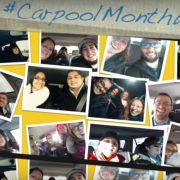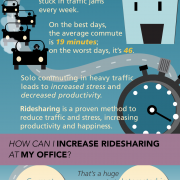Need to Recruit and Retain Top Talent? Don’t Ignore the Commute.
Employee commuter options are becoming increasingly important to members of the modern workforce.
For employers, the task to attract and retain the best available talent is becoming more and more complex. Members of the Millennial generation will make up three quarters of the workforce by 2025. So-called Generation Z is also entering the workforce in large numbers. Research consistently shows that these new workers hold a distinct set of values when it comes to what they look for in a job.
When it comes to choosing where to work, the new wave of professionals are interested in more than just money. They place high importance on achieving a positive work-life balance. They also strongly prefer organizations whose principles align with their own. For many workers, these principles include social and environmental responsibility. Millennials are particularly aware of ecological issues, and as such, they tend to take a positive view of organizations that are taking proactive steps to reduce their carbon footprints.
This growing trend extends beyond younger workers. A 2018 LinkedIn survey found that a whopping 85% of respondents said they would take a pay cut if it meant having a shorter daily commute. Job seekers are making increased use of tools that allow them to search for job opportunities that lie within their acceptable commuting time or distance range. These are clear signs that workers across age groups and demographics take the commute into consideration when weighing job offers. As an employer, looking to attract and retain top candidates, you can differentiate your organization by implementing programs to make life easier for commuters. Helping employees achieve a better balance between their work and off-the-clock lives are more productive and less likely to leave.
To that end, let’s take a look at some key employee commuter options that can give your organization a competitive edge.
Launch a commuter benefits program
Supporting commuters with a well-designed commuter benefits program is the single most effective measure your organization can take. These programs come in many forms and draw on a wide range of incentives and strategies to broaden their appeal. In general, the most effective strategies deliver meaningful rewards to commuters in a relatively compact time frame. This provides fast gratification while encouraging participants to adopt and maintain positive behavior changes.
One increasingly popular strategy is the points program. Points programs let commuters earn points when they track or log trips using a smart alternative to solo driving. They can redeem the points as they accrue over time for valuable rewards. City officials in Austin, Texas achieved high levels of participation when they introduced an innovative points program allowing municipal employees to cash in their points for paid time off – a highly meaningful reward. With that in mind, you should choose the rewards that appeal to your diverse workforce to help drive higher participation rates. Examples of possible benefits include:
- Gift cards for online or local retailers
- Tickets to sports or other events
- Charitable contributions
- Preferred parking
- Vouchers for mobility service providers
In addition to incentive programs, you can also offer a range of other attractive commuter benefits, including:
- Company-supported rideshare or vanpool networks
- Free or subsidized monthly public transit passes
- Earn-a-bike programs
- Parking cash-out programs
- Guaranteed ride home programs
Employers get the best results when they combine these offerings. So, instead of just setting up a points program, combine the points strategy with a few of the other options mentioned above to create a flexible program with wide appeal.
Offer flexible employee commuter options
In addition to commuter programs, employers can also appeal to job seekers by creating flexible options such as telecommuting and secure bicycle storage. Communications technology is making remote work a viable alternative in a growing number of jobs. Employers that continue to enforce rigid on-site participation policies increasingly risk losing their access to top talent.
While biking to work is not always a faster option than driving, it can reduce stress and contribute to a healthier, happier workforce. Simple things like secure bike storage, shower access, and lockers to encourage cyclists can choose to leave their cars at home more often.
Learn from the mistakes and successes of others
Organizations that haven’t adapted to the changing workforce and mobility landscape are facing increasing negative productivity and recruiting impacts. Many are experiencing higher rates of lateness and absenteeism, lower employee engagement, and higher turnover. Furthermore, failure to adapt can negatively affect your employer brand, making it even harder to recruit and retain quality candidates.
RideAmigos helps businesses of all sizes implement more effective employee commuter options.
RideAmigos’ cloud-based platform and native mobile apps offer features that make it easy for organizations to manage commuter programs and simplify access to smart transportation alternatives. Our industry-leading transportation demand management (TDM) tools work for businesses of all sizes. Let us show you how commuter benefits can help build your employer brand while promoting better health, decreased traffic, and sustainability.
Get started today to learn how RideAmigos supports a complete range of appealing and successful employee commuter programs.










Leave a Reply
Want to join the discussion?Feel free to contribute!